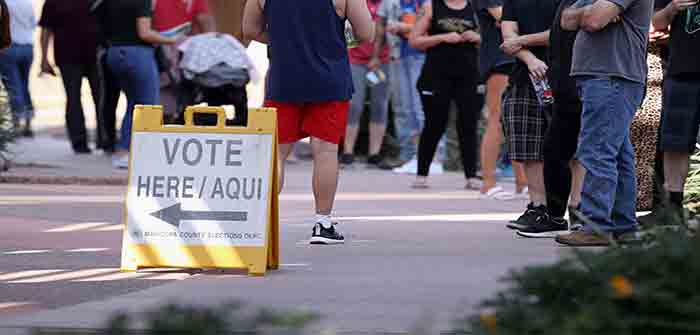
by Ryan Kelly at The Republic Brief
In a letter to the Department of Justice last year, an anonymous Democrat whistleblower accused fellow Democrats in Pima County, Arizona of adding approximately 35,000 votes to each of the Democrat candidates in the 2020 election.
This information came out Monday, during an “ad hoc” hearing in Tucson, where Arizona State House and Senate members met to discuss election integrity issues in Pima County.
During the hearing, experts provided evidence and testimony about the voting irregularities that allegedly took place during the election, including ballots from people not living where they voted, and inflated voter rolls across the Democrat-leaning county.
Arizona state Rep. Mark Finchem, who has received Trump’s endorsement for Arizona Secretary of State in 2022, read the letter. It was dated November 10, 2020, and addressed to the Criminal Division of the DOJ.
Please be advised the Pima County Recorder, located at 240 N. Stone Avenue in Tucson, Arizona, 85701 in Pima County, Arizona, and the Democrat Party added fraud votes. In the initial count of the vote by mail (VBM) totals released at 8 pm on November 3, 2020, There are approximately 35,000 fraud votes added to each Democrat candidates’ vote totals. Candidates impacted include County, State, and Federal Election candidates. Through the utilization of the automated ballot count machines in Pima County Elections, My understanding is that 35,000 was embedded into each Democrat candidates’ total votes. Below are the meeting notes.
In a meeting I was invited to by the Democrat party in Pima County, Arizona on September 10, 2020, no phones or recording devices were allowed. A presentation was given including detailed plans to embed 35,000 votes in a spread configured distribution to each Democrat candidate’s vote totals.
When I asked, “How in the world would 35,000 votes be kept hidden, or from being discovered?” It was stated that spread distribution will be embedded across the total registered vote range and will not exceed the registered voter count. And the 35,000 was determined allowable for Pima County based on our county registered voter count.
It was also stated total voter turnout versus total registered voters determined how many votes we can embed. The embedding will also adjust based on voter turnout. Because the embedded votes are distributed sporadically, all embedded votes will not be found if audited because embeds are in groups of approximately 1,000. This is so the County Recorder can declare an oversight issue or error, as a group of 1,000 is a normal and acceptable error.
Maricopa County’s embed totals will be substantially larger than Pima, due to embeds being calculated based on the total number of registered voters. When I asked, “Has this ever been tested, and how do we know it works?” the response was, yes, this has been tested and has shown significant success in Arizona judicial retention elections, since 2014. Even undetectable in post audits because no candidate will spend the kind of funds needed to audit and contact voters to verify votes and the full potential of the total registered voters, which is more than 500,000 registered voters. This year our Secretary of State has removed precinct level detail from election night releases, so candidates can’t see precinct over-votes.
This is what I have from this meeting. Just thought I’d report this. Not sure if you can do anything since I was unable to have a recording device at this meeting. Thank You.’
The whistleblower reportedly said he/she wished to remain anonymous and not be included any investigation.
Finchem said lawmakers were copied on the email, and over the ensuing months, they executed a “very quiet, but fruitful investigation.”
He also said that his team was able to verify that the IP address of the computer that sent the email is in Tucson, Arizona, but unfortunately, they wee not able to verify the identity of the whistleblower. Joe Biden’s DOJ reportedly refuses to investigate the allegations.
During the hearing, election experts described other potential election shenanigans in Pima County.
For instance, in the small town of Sells, Arizona, 1,375 residents were determined to be of “voting age.” However, 2,762 people were registered to vote in the town – more than double the voting age population:…
Continue Reading